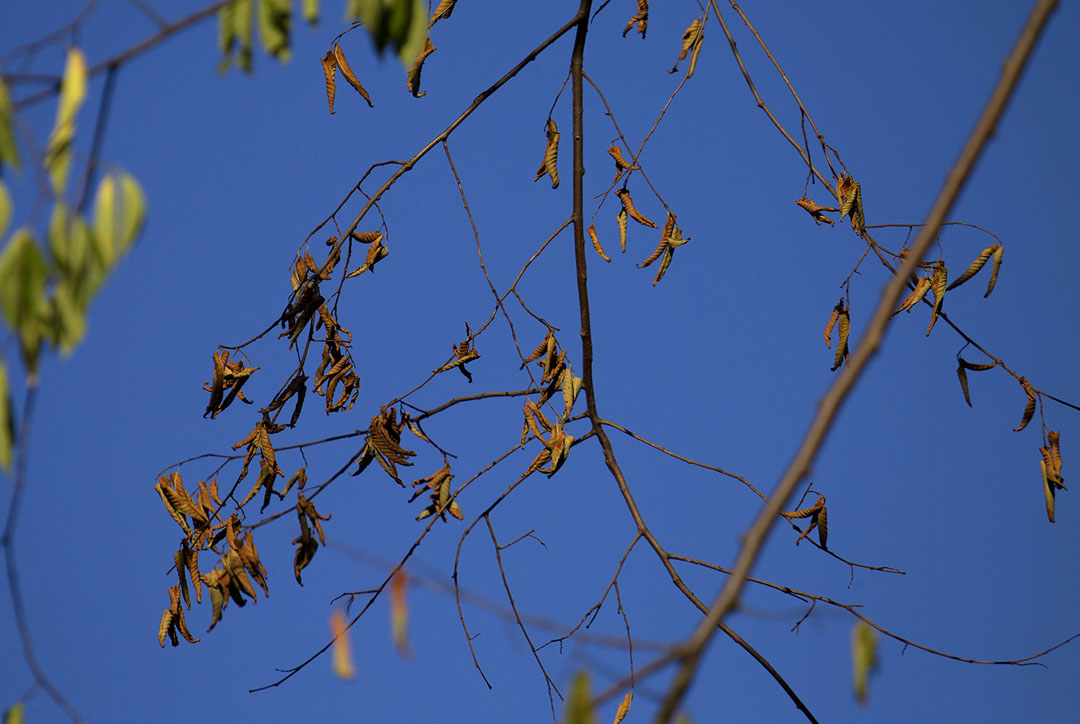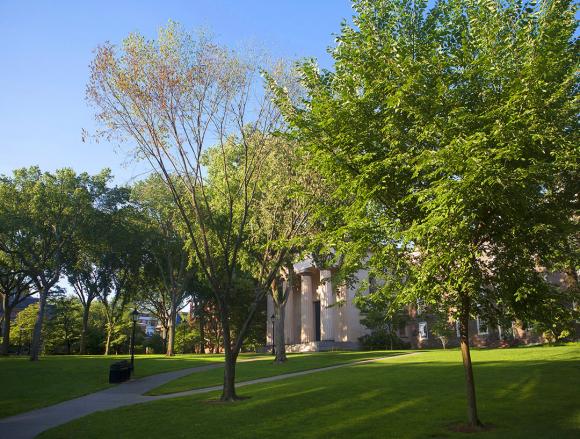On a sticky, overcast morning in early July, wilting leaves from two fading American elms drop in twisting flight to the verdant turf of the Front Green on the Brown campus.
Dutch elm disease is literally choking both trees — each just 10 to 15 years old — to death.
The disease attacks the vessels within a tree that carry water and dissolved minerals from roots to canopy. Lifeless leaves on outer branches typically mark the first sign of infection.

Five days a week, grounds personnel check Brown’s 82 American elms, one of the nation’s largest and oldest native elm collections on a college or university campus. This spring, staff spotted the first signs of disease in the two Front Green trees. They removed infected branches immediately. Sometimes that stops the disease from spreading. But the trees continued to deteriorate, so workers injected the trees with the fungicide, propiconazole. It is considered the chief treatment for stopping the spread of Dutch elm disease.
In fact, Pat Vetere, superintendent of grounds, credits past propiconazole treatments with keeping the ailment from killing some of the largest elms on campus such as those in front of University Hall, Rhode Island Hall, and Slater Hall.
This time, however, signs of the disease spread through each tree’s canopy. More leaves wilted and dropped, foliage turned brown and curled, branches died.
Sometimes Dutch elm disease will spread through highly susceptible trees in a matter of weeks. One of the infected trees is an American elm that grows near the Van Wickle gates. The other is an American elm cultivar, called Liberty, residing by Carrie Tower. Liberty was bred for its resistance to Dutch elm disease, but no cultivar is completely immune.
Because the ailment spreads through stems and roots, Brown will remove both trees this summer, plus grind down their stumps to help prevent spread of the fungus to surrounding healthy elms. During the fall planting season, the University will plant two new elms nearby.
Over the years, when previous elms needed replacing, Vetere and staff also planted other resistant versions of American elm, including the newer cultivars, Valley Forge and New Harmony.
Besides providing shade from the summer sun and acting as climate air conditioners, trees absorb carbon, conserve water, reduce urban noise, improve the air, and harbor wildlife. They may offer fruit or other products (e.g., maple syrup), screen out unwanted sites, and soften the landscape.
American elms mature into centuries-old, vase-shaped, multistemmed giants. At Brown, the relatively high canopies of such established trees allows for unobstructed sight lines between people and campus architecture, Vetere said.
It may take up to 100 years — when an American elm reaches maturity — for researchers to determine if a certain variety is resistant to Dutch elm disease and whether it will produce the vase shape prized by landscape professionals.
When Brown celebrates its 250th anniversary next year, the two newly planted elms will greet campus visiters on the Front Green. Vetere hopes that both trees will prove disease-resistant, eventually developing into large, graceful and handsome specimens.
If so, then maybe 100 years from now, those elms will also shade and shelter the University grounds when Brown celebrates its 350 anniversary in 2114.

